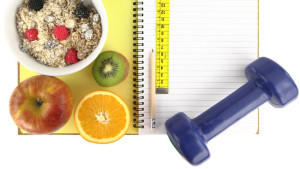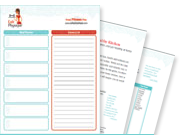Losing weight is easy. Some may work better than others, but nearly every diet book spells out the steps for dropping pounds. The issue is that most people are unable to maintain the weight they’ve lost. So diets work…but the results are usually temporary. In fact, a year after dieting, most dieters are heavier than they were when they started the diet. Now that stinks.
- The National Weight Control Registry (NWCR) tracks data from adults who have lost significant amounts of weight (30+ lbs) and
maintained the
weight loss for a year or greater.
- Hello! The following strategies are approaches they have found to successfully help maintain their weight loss.
 Set realistic weight goals. A 5 to 10% weight loss can have significant
Set realistic weight goals. A 5 to 10% weight loss can have significant
health improvements. Establish achievable goals and add to them as they
are reached. Reassess goals every 6 months.
Eat a diet low in fat and high in unrefined carbohydrates. A low-fat, high-carbohydrate eating plan is the desired approach to
maintaining weight loss. Select carbohydrates that are high in fi ber and
unrefined, such as, fresh fruit, vegetables, whole grain cereal and breads,
brown rice, beans and legumes, and whole-wheat pasta.
Self-monitor food intake and activity level. Consistently monitor food intake and activity level. Become familiar with what, how much and when you eat and are active. Regular assessment can coincide with weight loss changes and help you identify what may be triggering weight regain. Use journals, food records, and activity records regularly. Share them with your weight loss provider.
Consume enough calcium. High calcium diets (food versus calcium supplements) may reduce the amount of calcium in fat cells, which in turn increases fat breakdown and reduces fat storage. Consuming 1,000 mg/day (3½-cups of dairy in the form of low-fat milk, cheese and yogurt) has demonstrated these benefits.
Monitor calorie intake. Weight loss can be maintained with a calorie
controlled diet after the weight goal is achieved. Become familiar with
portion sizes and the average calorie levels of food to help achieve a calorie controlled eating plan that will maintain your body weight.
 Start your day with breakfast and avoid skipping meals. Consume 5 smaller meals and snacks per day. Keeping yourself nourished can help prevent over-eating at different points of the day.
Start your day with breakfast and avoid skipping meals. Consume 5 smaller meals and snacks per day. Keeping yourself nourished can help prevent over-eating at different points of the day.
Be physically active!
Spend 60 minutes per day doing moderate intensity physical activity, e.g., brisk walking, which will burn about 400 calories per day. Physical activity is identified to be one of the most important components of maintaining weight loss successfully. Lifestyle activity (doing those daily household chores like gardening, mowing, vacuuming, and chasing the
kids) can be counted. Walking stairs for 10 minute intervals 3 times per day has the same calorie burning power as walking stairs continuously for 30 minutes. Picking activities you enjoy is most important.
Shocking information? No, not especially. There’s nothing revolutionary or unheard of here. However, our personal trainers and registered dietitian nutritionists constantly get questions about the newest fads, so it’s clear that many people still don’t actually believe that these tried and true approaches are the best answer to lasting weight loss.


